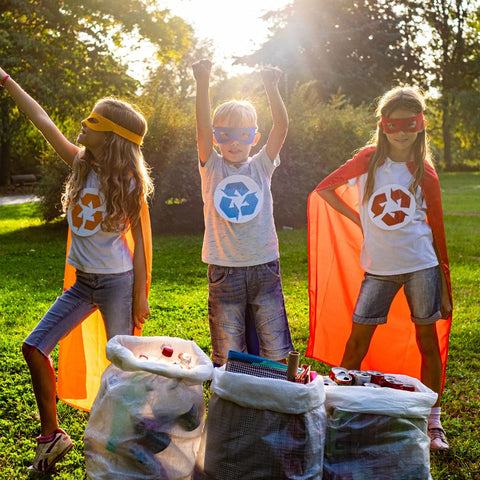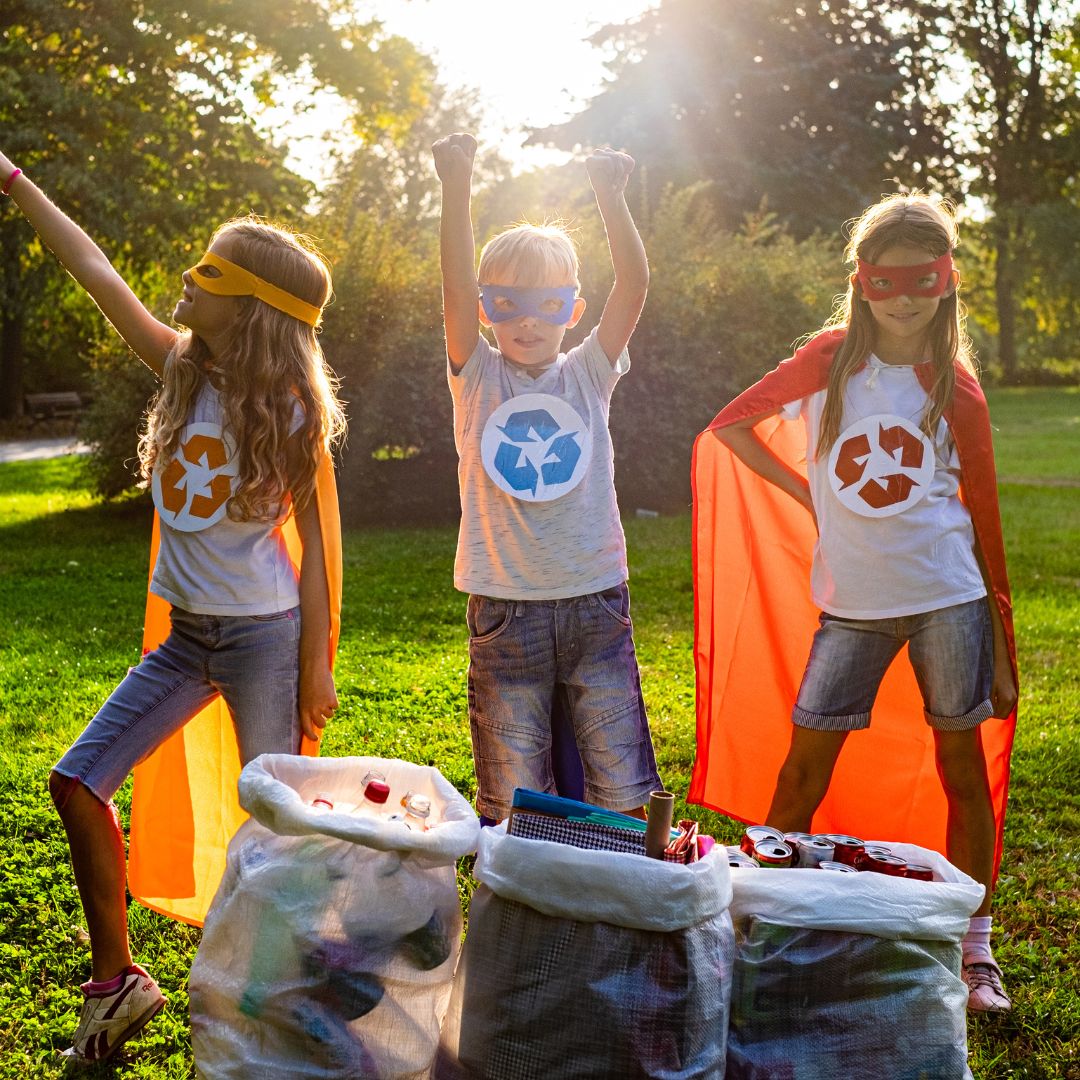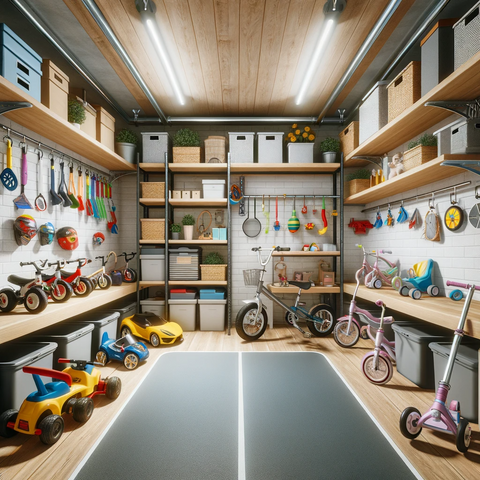
Published: 29.2.24
Updated: 22.7.24
Have you ever looked around your home and wondered what to do with the mountains of toys your kids have outgrown or no longer play with?
It's not just about reclaiming your space—it's about taking a step towards a more sustainable future.
Today, let's talk about why recycling your children's toys isn't just good for your home, but essential for our planet.
The topic of toy waste might not be the first thing that comes to mind when we think about environmental issues, but it's a significant one.
Benefits of Recycling Toys
Every year, countless toys end up in landfills, contributing to plastic waste and environmental harm.
But there's good news!
By recycling children's toys, we can make a substantial impact on reducing this waste.
This article is here to walk you through the key reasons why recycling toys is a step we should all be taking.
Reduce Waste and Landfill Accumulation:
The Problem with Plastic Waste:
Imagine every toy your child has ever broken or outgrown. Now, multiply that by millions of households.
That's a lot of plastic ending up in our landfills, where it will stay for hundreds, if not thousands, of years, releasing harmful chemicals and contributing to pollution.
The Environmental Impact:
Plastic doesn't just disappear. It breaks down into microplastics, contaminating our soil, waterways, and even the food chain.
This cycle of pollution has far-reaching effects on ecosystems and wildlife.
A Call to Action:
By choosing to recycle toys, we can significantly reduce the volume of plastic waste.
It's a simple step with a powerful impact, and it's something every family can start doing today.
Step-by-Step Guide to Recycling Kids' Toys
Recycling kids' toys is an essential practice for reducing waste and conserving valuable resources.
Many toys are made from materials that can be reused or repurposed, but the process can be complex due to the variety of components involved.
Here is a comprehensive step-by-step guide to help you recycle kids' toys effectively.
| Step | Description |
|---|---|
| 1. Assess the Condition of the Toys | Before deciding to recycle, assess whether the toys are still in good working condition. If they are, consider donating them to charities, schools, or community centers. This not only extends the toy's life but also benefits others. |
| 2. Remove Batteries and Electronic Components |
Remove Batteries: Batteries can be hazardous if not disposed of properly. Take them out and recycle them separately at designated battery recycling points found at many supermarkets and electronic stores. Electronic Components: Disassemble toys to remove any electronic components. These parts often require special disposal methods to avoid environmental harm. |
| 3. Clean the Toys | Thoroughly clean the toys to remove any dirt, debris, or personal items. This is particularly important if you plan to donate them. |
| 4. Sort by Material |
Plastics: Identify the type of plastic (e.g., HDPE, ABS) and check if your local recycling program accepts it. Some specialised programs, like TerraCycle, accept a wide range of plastic toys. Metals: Metal components can be recycled with scrap metal. Ensure they are clean and free from non-metal parts. Wood: Untreated wooden toys can sometimes be composted, but treated wood should be disposed of properly to avoid environmental harm. |
| 5. Find Recycling Facilities or Programs |
Local Recycling Centers: Many centers accept electronic toys and other materials. Check their guidelines to ensure they can handle the specific types of toys you have. Specialised Programs: Programs like TerraCycle offer specific recycling solutions for toys that are not accepted by local councils. Manufacturer Take-Back Programs: Some toy manufacturers have take-back programs for recycling old toys. |
| 6. Donate or Sell Usable Toys |
Donate: Charities, schools, and community centers often accept toy donations. Ensure the toys are safe and clean before donating. Sell or Give Away: Use online platforms like eBay, Gumtree, Freecycle, or local buy/sell groups to sell or give away toys. This extends their life and reduces waste. |
| 7. Upcycle or Repurpose |
DIY Projects: Transform broken toys into art, planters, or other creative projects. This can be a fun and sustainable activity for the whole family. Community Art Projects: Donate toys to artists or community centers for use in creative projects. |
| 8. Follow Safety and Legal Guidelines |
Safety Checks: Ensure toys are safe and free from sharp edges or loose parts before donating or repurposing. Legal Disposal: Adhere to local regulations for disposing of electronic components and hazardous materials like batteries. |
| 9. Educate and Involve Children |
Educational Activities: Explain why recycling is important and how it helps the planet. Make sorting and recycling a fun and engaging activity. Positive Reinforcement: Encourage children to donate toys they no longer use, teaching them the value of generosity and environmental responsibility. |
| 10. Stay Updated | Recycling guidelines and programs can change, so stay informed about the latest options and regulations in your area. Use resources like local council websites or recycling locator tools to find the most current information. |
By following these steps, you can ensure that your kids' toys are recycled responsibly, reducing waste and conserving resources for future generations.
Teach Children About Environmental Responsibility:
A Lesson in Sustainability:
Recycling toys provides a fantastic opportunity to teach our children about sustainability and the importance of taking care of our planet.
It's about instilling values that will last a lifetime.
Fostering Eco-Consciousness:
Getting kids involved in recycling can help them understand the concept of reuse and conservation.
It's a hands-on way to show them how their actions can make a difference.
Tips for Educating Your Kids:
Start with explaining why some toys are being sorted out for recycling or donation.
Encourage questions and make the process fun and engaging. It's about building a foundation for environmentally conscious decision-making.
Conserve Valuable Resources:
The Cost of Toy Production:
Toys aren't just made out of thin air. They require energy, water, and raw materials—resources that are finite and often extracted at a significant environmental cost.
Understanding the Impact:
The process of creating new toys—from extraction to manufacturing—can be resource-intensive.
This not only depletes natural resources but also contributes to pollution and greenhouse gas emissions.
The Role of Recycling:
Recycling toys means we're making the most out of the materials already in circulation.
It conserves resources and reduces the need for new materials, easing the strain on our planet.
Support the Circular Economy:
Closing the Loop:
The circular economy is all about reducing waste and promoting the reuse of resources.
By recycling toys, we're contributing to a system that values sustainability over disposability.
Reducing New Production:
When we recycle toys, we help decrease the demand for new products.
This not only conserves resources but also reduces the environmental footprint associated with manufacturing.
A Sustainable Choice:
Encouraging a circular economy through toy recycling is a proactive step towards a more sustainable future.
It's about making choices that benefit both the planet and future generations.
Donate to Children in Need:

Giving Back:
Donating toys can make a significant difference in the lives of underprivileged children.
It's a way to recycle with purpose, providing joy and learning opportunities to those in need.
Where to Donate:
Many charities and organisations welcome toy donations.
Do some research to find a reputable charity that aligns with your values and ensure the toys are in good condition before donating.
The Joy of Sharing:
Encouraging your children to donate toys they no longer use can teach them valuable lessons about kindness and generosity.
It's a way to declutter responsibly while making a positive impact on someone's life.
Create a Clutter-Free and Organised Space:
The Benefits of Decluttering:
A cluttered home can be overwhelming and stressful. Recycling and donating toys can help create a more organised, peaceful living environment.
Freeing Up Space:
An organised space is not only more pleasant to live in but also safer and more conducive to play and creativity.
It's about creating a home where every item has a place and purpose.
Decluttering Tips:
Start by sorting toys into categories: keep, recycle, donate.
Make it a family activity, and be mindful of what truly brings joy and value to your children's lives.
Latest Statistics on Toy Waste and Environmental Impact
The toy industry, a significant contributor to global plastic waste, faces increasing scrutiny over its environmental impact.
Here are the latest statistics and insights into the environmental footprint of toys:
| Category | Statistics |
|---|---|
| Plastic Consumption and Waste |
|
| Electronic Waste (E-Waste) |
|
| Environmental Impact of Specific Toys |
|
| Consumer and Industry Trends |
|
| Recycling Initiatives |
|
| Future Outlook |
|
In conclusion, while the toy industry has a significant environmental impact, there is a growing movement towards sustainability.
Increased consumer awareness and innovative recycling programs are crucial steps in reducing the ecological footprint of toys.
Case Studies and Success Stories of Toy Recycling
LEGO Replay Initiative
Overview: LEGO Replay is a program designed to encourage the reuse and recycling of LEGO bricks. The initiative allows LEGO owners to donate their used bricks to children's charities.
Impact:
- Reuse Rate: 97% of LEGO bricks are kept or shared by owners, often passed down through generations.
- Recycling Achievement: Over 460,000 kilograms of LEGO bricks have been recycled.
Significance: This initiative reduces waste and ensures that the high-quality and durable nature of LEGO bricks is utilized to its fullest potential.
Toys 4 Life
Overview: Toys 4 Life is dedicated to the re-use and recycling of unwanted plastic toys. The organization collects toys and either reuses them or recycles the materials.
Impact:
- Environmental Benefits: Reduces plastic waste and pollution, particularly in oceans.
- Charitable Contributions: Generates funds for various charities and provides toys to children in deprived parts of the world.
Significance: Toys 4 Life addresses environmental concerns and supports social causes.
Recycle to Read
Overview: Backed by Hasbro and Tesco, this initiative focuses on recycling hard plastic toys and promoting toy reuse.
Impact:
- Educational Outreach: Educates families about the environmental benefits of toy recycling and rewards them with books for participating.
- Community Engagement: Schools can earn points for rehoming or recycling toys, which can be exchanged for books.
Significance: Combines environmental sustainability with educational benefits.
TerraCycle and Hasbro Partnership
Overview: A free national recycling program for toys and games created through a partnership between TerraCycle and Hasbro.
Impact:
- Comprehensive Recycling: Collects, cleans, and separates toys by material type, recycling them into raw formats for new products.
- Innovation in Recycling: Finds solutions for plush toys that cannot be mechanically recycled.
Significance: Represents a significant step towards reducing toy waste and promoting a circular economy.
The TOY Project
Overview: Founded in London, this project focuses on collecting, repairing, and reselling used toys, growing into a community hub.
Impact:
- Community Support: Provides toys to children in need, supports play therapists, and funds social initiatives in the neighborhood.
- Sustainable Practices: Reuses and resells toys, reducing waste and promoting sustainability.
Significance: Demonstrates how environmental initiatives can also support community well-being.
Mattel's Playback Program
Overview: Allows parents to return old toys to the company for recycling.
Impact:
- Sustainability Goals: Mattel aims to use 100% recycled, recyclable, or bio-based plastics in all its toys and packaging by 2030.
- Waste Reduction: Ensures that old toys are recycled into new products.
Significance: Sets a benchmark for the toy industry, encouraging other manufacturers to adopt similar practices.
Conclusion
These case studies and success stories illustrate the growing efforts within the toy industry to address environmental concerns through innovative recycling and reuse programs.
By promoting circular economy principles, these initiatives not only reduce waste but also support social causes and educational efforts, paving the way for a more sustainable future.
Conclusion:
Recycling your kids' toys is more than just a way to tidy up—it's a step towards a more sustainable and thoughtful way of living.
It's about teaching our children the value of responsibility, conservation, and generosity.
By making recycling a part of our family routine, we can have a positive impact on the environment, our community, and our own home.
Let's work together to create a brighter, cleaner future for all.
FAQ: Recycling Kids' Toys
How can I tell if a toy is recyclable?
Determining whether a toy is recyclable depends on its materials. Most plastic toys are marked with a recycling symbol and a number indicating the type of plastic. You can check your local recycling guidelines to see if that type of plastic is accepted. For toys made of other materials like wood or metal, consult with your recycling center or look for specialised recycling programs that handle these materials.
What should I do with toys that are not recyclable?
For toys that cannot be recycled through standard municipal services, consider upcycling or donating. Upcycling involves repurposing the toy for another use, either as part of a DIY project or by donating to artists and community centres. If the toy is still in good condition but not suitable for recycling, donating to charity shops, family shelters, or children’s hospitals is a wonderful way to extend its life and benefit others.
Are there eco-friendly alternatives to traditional plastic toys?
Yes, there are many eco-friendly toy alternatives available that are designed with sustainability in mind. Look for toys made from natural materials such as wood, organic cotton, or recycled plastics. Brands that prioritise sustainability often use non-toxic, biodegradable materials and environmentally friendly manufacturing processes. These toys not only reduce environmental impact but are also safer and healthier for children.
How can I encourage my child to participate in recycling their toys?
Engaging your child in the recycling process can be educational and fun. Start by explaining the importance of recycling and how it helps the planet. You can make sorting and preparing toys for recycling a game, rewarding them for making eco-conscious decisions. Encourage them to donate toys they’ve outgrown to children in need, teaching them the value of generosity and the positive impact of recycling on the environment and community.
Get in Touch 🚀
Loved our article on “Here's Why You Should Be Recycling Your Kids Toys” Got the itch to dive into more wheely-awesome info?
Whether you're a parent or a grandparent, we're here for all your kids ride-on toy questions! 🚗💨
Feeling click-happy?
Jump straight into our wonderland at RiiRoo.com.
Or, if you're more the chatty type, give our Live Chat a whirl and let's talk toys!






Share:
How to Drive a Go Kart in the Rain: Wet Track Tips for All Skill Levels
What Is The Difference Between Front, Back And All Wheel Suspension In Ride On Cars?